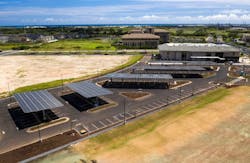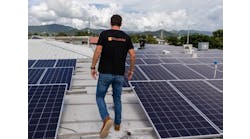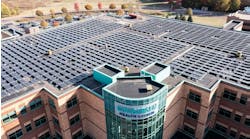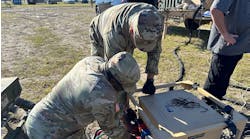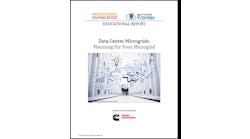The once and future human and financial tolls of climate change are staggering and getting worse— sometimes even too cataclysmic to grasp in the near term.
Entities such as the World Health Organization and World Economic Forum predict close to 15 million additional deaths will be attributed directly to extreme weather impacts such as heat waves, hurricanes and, by extension, food availability and quality. The financial impact could cost the world economy $23 trillion by 2050, according to a report by insurance giant Swiss Re.
To some these may seem like abstract prophecies, but to those in vulnerable regions and in the health care sector these are futuristic horror stories already coming true.
No one probably feels the present reality of such dire forecasts as much as those in the health care sector. Industry giant Kaiser Permanente, for instance, owns and operates facilities on numerous islands and in threatened coastal regions.
These locations include the Hawaiian island of Oahu, where the company contracted with energy project developer Ameresco to build a renewable energy microgrid for the West Oahu Primary Case Medical Office Building (MOB).
Such projects may sound like a no-brainer for health care advocates and true climate change believers, but these are also companies that understand that microgrid projects are expensive and have to justify the bottom line.
“One of our missions is to improve the health of the communities we serve, and the climate crisis is a threat to human health,” Ramé Hemstreet, chief sustainable resources officer for Oakland, California-based Kaiser Permanente, said in an exclusive interview with Microgrid Knowledge.
“We resolved that one way to improve that was to install solar at all locations where it penciled out,” and made economic sense, Hemstreet recalled. “We wanted to reduce emissions but do no harm financially.”
Kaiser Permanente has installed on-site solar at more than 100 of its 700-plus locations, including hospitals and MOBs. It does not aim to reproduce solar-and-storage on-site at every company site, given inner and outer limitations such as space availability and state policies toward net-metering rates (where utilities pay solar customers for energy delivered back into the main grid).
Sometimes the cost of solar-plus-storage is greater than the value in net-metering reduction or grid services benefits such as demand response. Other times, the microgrid equation (with a controller system balancing all of the resources and the ability to operate in island mode if the grid goes down) makes solid economic and health care sense.
“There are a number of variables,” Hemstreet pointed out. “Siting, utility rate structure including time-of-day dynamic pricing, and net metering. You don’t want to overbuild and be forced to net meter in an area where the policies are not economically beneficial.”
Kaiser Permanente opted to undertake a major project at the new West Oahu MOB, beginning construction in June 2019. The building and microgrid construction projects, undertaken concurrently, were completed in April 2021. The on-site power includes a nearly 400-kW (direct current) solar photovoltaic array, paired with an 892-kWh battery energy system.
The key value chain goal was dropping the facility’s grid energy expenditures dramatically.
“We’re saving 25% to 35% compared to what we’d be paying if connected to the grid alone,” Hemstreet said. “It proves the point that a green microgrid could help achieve both of those goals: clean energy and financially viable.”
The medical care giant currently gains close to 4% of its systemwide electricity needs via on-site solar. The company also utilizes virtual power purchase agreements (VPPAs) to offset the remainder of its Scope 2 (purchased utility power) emissions.
Under a VPPA, the customer doesn’t receive the renewable power generated directly, but its long-term off-take agreement enables a developer to gain financing to build the new renewable generation project and interconnect it into the overall grid.
The West Oahu MOB’s battery system is ample enough to allow Kaiser Permanente to keep the facility running for several hours in the event of a grid outage. The solar gives the company an alternative to utility-scale power on an island that must import much of its power plant generation resources and, thus, is expensive to customers.
“It’s an economic driver,” Nicole Bulgarino, Ameresco’s executive vice president for federal and utility solutions, said of the decision to install on-site power at the health care facility. “It’s hard to put a price tag on resiliency.”
Ameresco is a Gold Sponsor for Microgrid 2024
Happening April 22-24 at Marriott Waterfront in Baltimore
Registration Open and Content Schedule Listed
Siting and regulatory hurdles are only two of the challenges facing microgrid deployment at facilities. Another is developing a load profile — how much energy the facility uses — by taking stock of load at 15-minute intervals.
There are keys to understanding peak and base loads at existing facilities. At a new building project, however, you must rely on “synthetic load profiles.”
“Synthetic is a fancy word for anticipated,” Kaiser Permanente’s Hemstreet quipped. “This being a new building (the West Oahu MOB), we didn’t have any data … so they had to provide us with a synthetic load profile.”
Synthetic forecasts require actionable information fast when the project is up and running. So far, so good, the participants say, as Kaiser Permanente’s West Oahu MOB makes a successful business case in both avoided costs and sustainability gains.
“Green microgrids allowed us a triple win — saving money, reducing the carbon footprint and, if the power grid goes down, in most cases we’re able to stay open,” Hemstreet noted.
